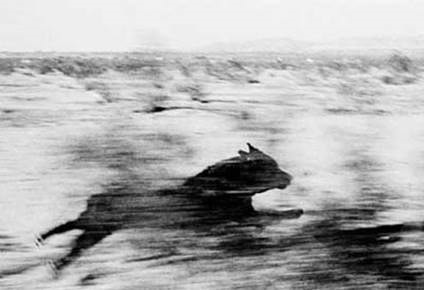
John Divola
American, 1949-
Dogs Chasing My Car in the Desert Series, 1996-1998
Inkjet print
44 x 54"
Courtesy of the George Eastman House

“Contemplating a dog chasing a car invites any number of metaphors and juxtapositions: culture and nature, the domestic and the wild, love and hate, joy and fear, the heroic and the idiotic. It could be viewed as a visceral and kinetic dance…[or] seeing that a camera will never capture reality and that a dog will never catch a car, evidence of devotion to a hopeless enterprise.” - John Divola
COMMENTS
Few recent photographs speak as directly or eloquently about the relationship between civilization and nature as this relatively unknown black-and-white image from American photographer John Divola’s series, “Dogs chasing my car in the desert.”
A black canine races forward across the foreground in a shadowy blur, streaks created by grass or other objects creating near-horizontal lines along the animal’s powerful body, creating a sense of speed, and perhaps, inevitability. The dog’s front and rear legs are extended, his ears cocked slightly back. A wide-opened, ash-white desert stretches off into the distance, ending at a mountainous horizon.
Divola worked on the series in 1996, training his lens on a phenomenon that nearly everyone in the Western World has witnessed by now — dogs on the defensive, boastfully chasing multi-ton machines down highways and back roads, a no-win expression of territorialism. We all know the story. Most dogs fall back after a short chase, tiring out, realizing they can’t keep up with the metal beast that has strayed into the wilderness, or believing they have won some David-and-Goliath battle against a strange, threatening, but ultimately turn-and-run foe. Other dogs get hit and die — an inevitable tragedy given the unstoppable will of nature and civilization’s obsession with conquering the earth.
“The process was simple; when I saw a dog coming toward the car I would pre-focus the camera and set the exposure. With one hand on the steering wheel, I would hold the camera out the window and expose anywhere from a few frames to a complete roll of film,” Divola wrote in a 2004 statement on the project.
“It could be viewed as a visceral and kinetic dance,” the 2004 statement continues. “Here we have two vectors and velocities, that of a dog and that of a car and, seeing that a camera will never capture reality and that a dog will never catch a car, evidence of devotion to a hopeless enterprise.”
The apparent simplicity of the photograph, with little more than a dusty, desert backdrop, a fast dog, and some blurry shrubs shot by a driver on grainy film, conceals its conceptual depth, and its superb, and plain, compositional execution, which invites numerous but non-contradictory interpretations. While the metaphor the photograph contains is crystal clear, the message is not obvious at first glance, given the compositional weight of the black dog on a near-white background. Nonetheless, Divola takes a direct approach to his subject in this photograph and others in the series. It’s a tack contemporary photographers would be wise to follow given the competition they face from racier, faster, more colorful media. For contemporary photography to get any attention in our times, it must be received like a kidney punch, which is what Divola manages, revealing a profound drama with the smallest number of possible players and few props.
- John Sevigny, "On John Divola’s Dogs Chasing My Car in the Desert," Guernica, a Magazine of Art & Politics, 30 May, 2009
http://www.guernicamag.com/daily/john_sevigny_on_john_divolas_d/
SBMA CURATORIAL LABELS
While photographing his series Isolated Houses in the remote desert areas of southern California, Divola’s truck became an object of pursuit for random dogs. No doubt the highlight of their day, dogs seemed to appear from nowhere to take up the chase, bounding and leaping and running alongside the photographer’s vehicle. To record the pursuit, Divola aimed a 35 millimeter, motor-driven camera out his moving truck window, unable to see what he might capture. The resulting images exude raw physicality and at the same time, exuberance. The photographer commented, “But they [the dogs] come out and physically just dive into the doing of this thing, and to me that’s pure joy.”
The sequential image of 36 frames (one roll of 35 mm film) in D25 Run Sequence is reminiscent of the motion studies done by Eadweard Muybridge at the University of Pennsylvania beginning in 1887. In eleven published volumes, Muybridge reproduced visual documentation of the mechanics of both human and animal locomotion. Divola’s images, by contrast, record both the essential movement and the different paths and personalities of dogs on the run.
- John Divola, As Far As I Could Get, 2013
